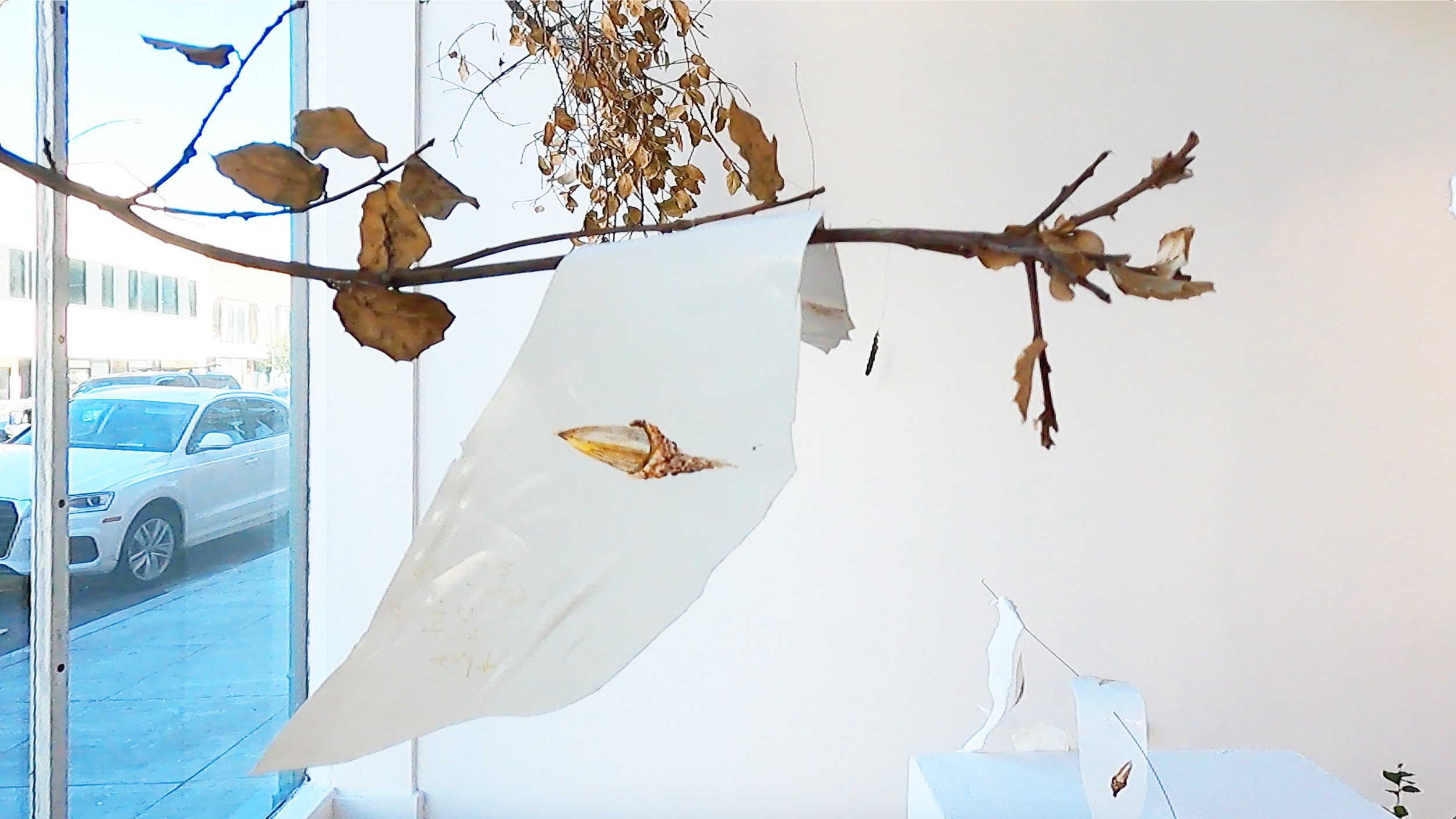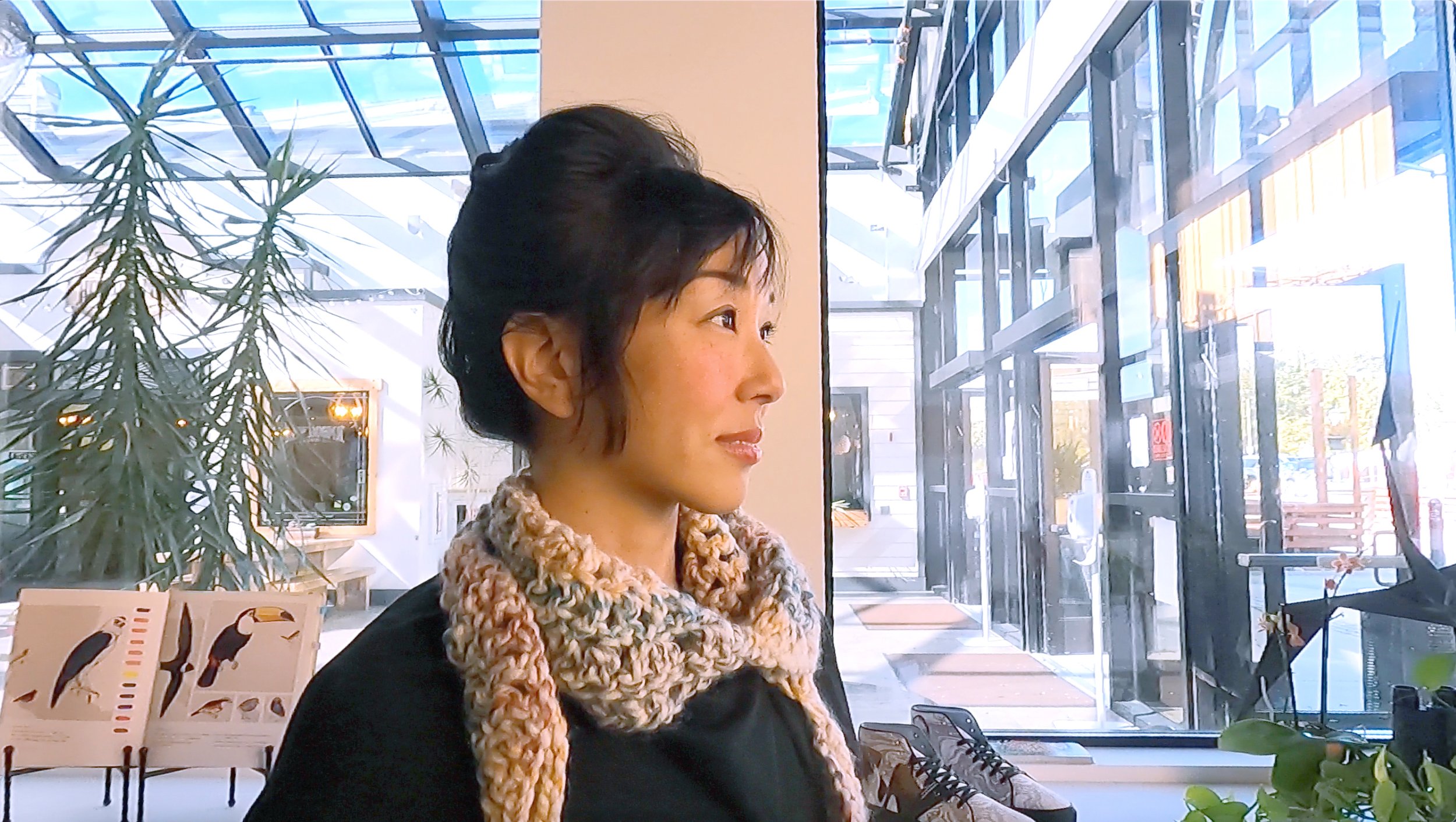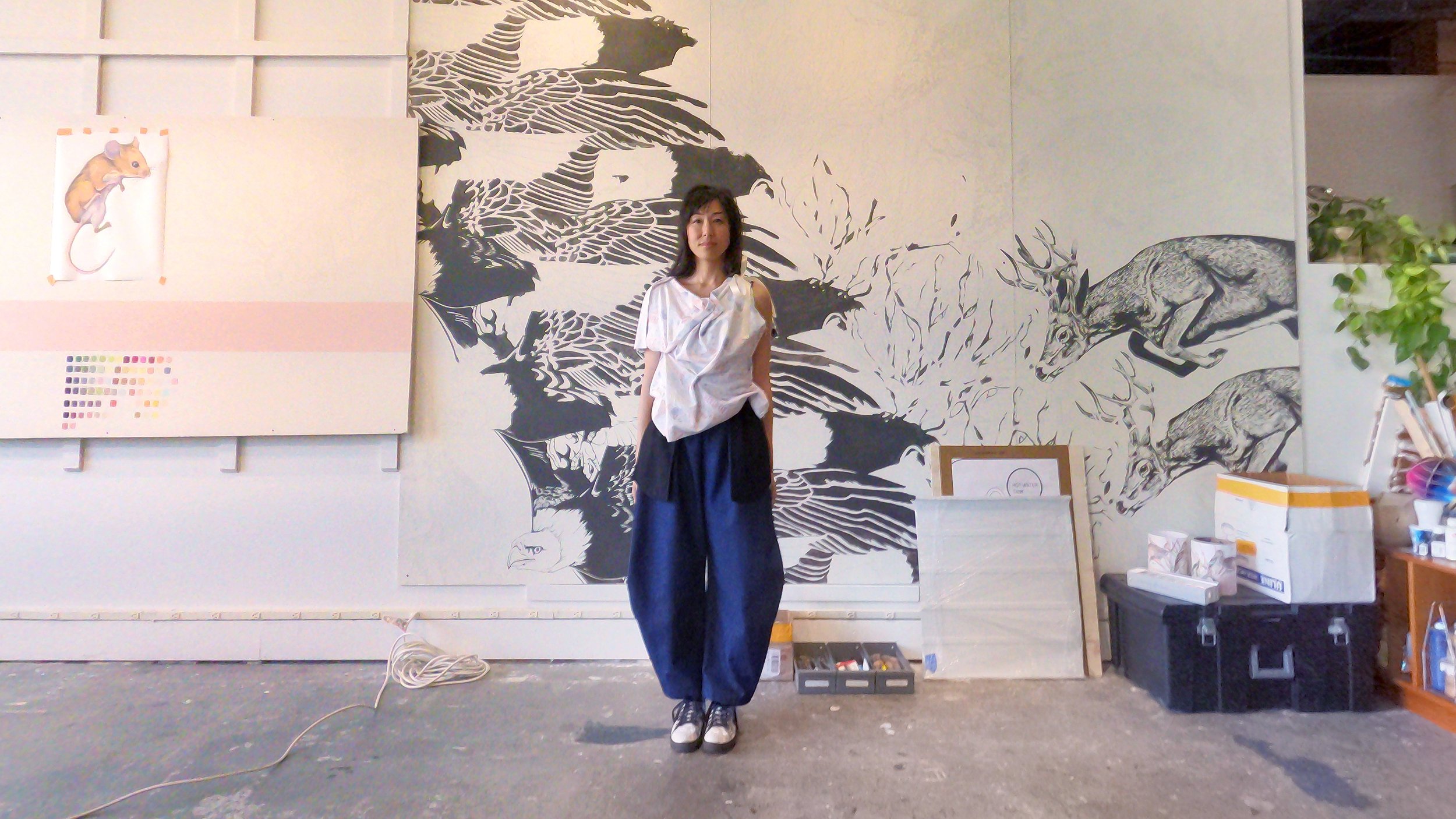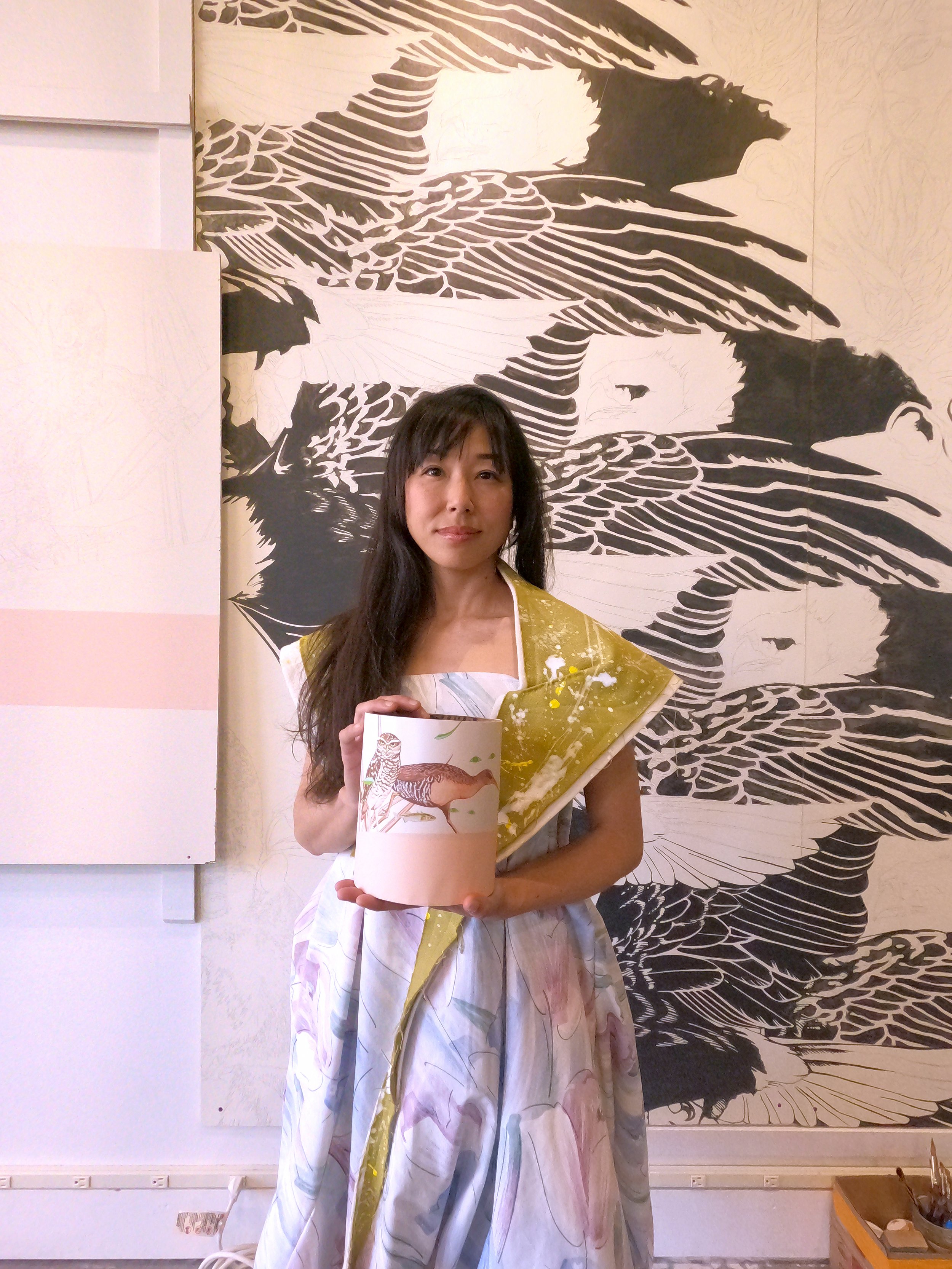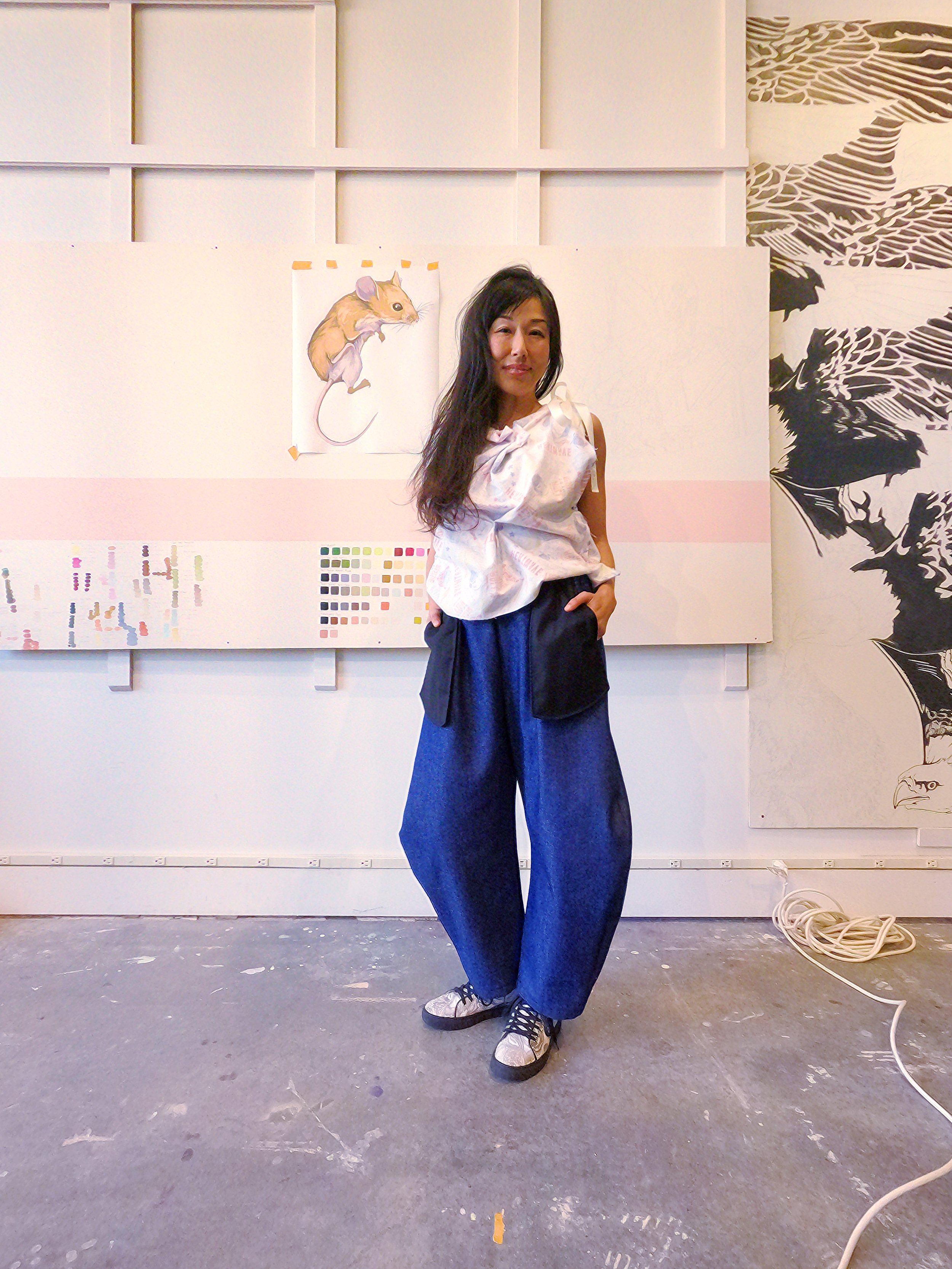Alicia Escott
Photographs by Akiko Tsuji
I set my phone on the white plinth next to me. "Oh, be careful," Alicia said. "These are the seedlings.” I turned around and saw that there were tiny little seedlings aligned upright in rows like hair growing out on top of a plinth, and I had unintentionally flattened some of them with my phone. "Don't worry about it, these are so hard to see. I can replant them." She picked one of the seeds and placed it back in the crease. "I can always get more," she said, in her usual calm manner. Later on it struck me…in a small way that was analogous to the way the earth deals with damages caused by humans: What has been done is done - it will have to repair and adapt - with or without human help.
Alicia Escott is an interdisciplinary artist working with environmental and social justice issues, she feels her role is to bear witness to climate change and upheaval. A year ago she held an installation entitled “Mast Year” at Dream Farm Commons in Oakland around a concept that seems more immediate than ever as none of us, no matter what political leanings may be, can ignore all the recent weather-related disasters occurring around the globe more frequently and with ever more intensity. The installation is like a trove - a room carefully arranged with dried leaves, oak branches, seedlings, mushrooms, and plants grown in plastic bags; even the phone, cables, and delicate acorn paintings on ripped strips of plastic sheets seem like a holy preservation. Becoming aware of the beauty and survival of our environment is perhaps the simpler message this exhibition conveys without preaching. I ask about her work, and she tells us thoughtfully as though she is balancing sensitive mobile levers holding weights of where ‘nature’ starts and ends, while simultaneously questioning where ‘art’ starts and ends.
Akiko Tsuji: Can you explain the Mast Year installation?
Alicia Escott: Mast Year is an immersive but disparate installation, in many ways, it tries to echo what it feels like to wander in an oak grove, it's full of tiny details and surprises for the more explorative viewer to discover. The premise of the installation was an exploration of the mutual aid communities fostered by California Oaks and of the ways they have coevolved with fire. The work is rooted in habitat restoration and oak ecologies, working in collaboration with nearby oaks in the meadow you visited last year. - [See the November 3rd, 2022 post, Meet The Artists of the Secret Meadow.]
A question I have had in my work for a long, long time is asking what is it we talk about when we talk about “nature”? It’s a really problematic term, “nature”. Implying something to point to, outside of us and our world. Why is plastic not “nature”? What hubris is it of us to think we synthesized a material that exists outside of “nature”? And yet, of course, it is not. Plastic is both part of nature, and yet it is something wholly different. Through my work and my engagement with the world, I’ve come to understand this idea we call nature as a series of co-evolved relationships that occur over time, or, in more simple terms— as a community. Oaks are beings that create community, and live within an ecological community they create through the generous abundance of their acorns. Dissimilarly, Plastic, for example, has been produced so abundantly in such a short time scale, that it hasn’t been able to coevolve those relationships. It doesn’t have an intact community. Not yet, at least.
But just as much as this installation has elements of oak ecologies: oak branches, chanterelle, bay leaves, jay feathers, it too has man-made objects, plastic vinyl used to shrink wrap buildings in construction, burnt-out iPhone chargers, their precious metals oozing out, a branch on the floor that looks like its growing mushrooms and an oak sapling, which on further inspection is a burnt out PVC pipe recovered from the Sonoma fires. These “natural” and “unnatural” materials are entangled with messy, unclear boundaries throughout the installation, complicating the distinction. Elements come out of the walls themselves pointing to the materials of the building part of this treeless street in downtown Oakland that is still very full of community. Part of the show was planting oak saplings started from acorns in the empty city tree plots outside of the Gallery.
AT: Can you describe the process of creating the installation? Do you sketch out the installation layout? If so, do you create the artwork and the pieces before planning the layout, or do you sometimes make pieces and arrange them as you go?
AE: This is a great question and I want to be clear there was a lot of work in this little show, many elements were made prior, some for other installations. The drawings of acorns on plastic were each made during the pandemic, one a day, each a meditation on the possibility inherent in a seed, likening that to the social justice uprisings that the pandemic sewed. Much of my work in the residency was combining drawings and sculptural elements I had been making for a couple of years. I often think of this sort of installation as drawing in space. For this reason, I usually install my work myself, I don’t usually just drop it off with a curator or gallerist, much of the work is in the installation itself. I don’t do a ton of sketching when I install (though I would probably advise my students to do that, and it might help if I did!) I brought a lot of work and elements into the space and then worked with those, bringing things together in unusual ways responding to the space itself, working intuitively, and trying to see what the living elements themselves wanted.
AT: What is your approach to addressing the climate issues and concerns? Loud and vocal, or subtle and quiet? How effective is it? Tell me your thoughts on your creations, installation, and environmental concerns.
AE: I don’t have any one given approach, and I think we need every approach on the table. Some works are more overt, others more subtle. I spent much of my education answering the question, “If you want to save the planet, why are you in art school,” it was very unpopular when I was younger to bring these issues into the work. But in working with scientists, policymakers, and activists over the years, I have learned they all desperately want artists of all sorts involved. Now, in the arts, these issues are MUCH more in the zeitgeist.
We have had over 40 years of solid climate science, we need cultural shifts arguably much more than any new study. I’ve been working with these issues for a long time in many ways and mediums, — my work with 100 Days Action is more activist-based, others like my work as The Bureau of Linguistical Reality are about empowering others by just giving them agency to name the feelings they have as they live through climate crisis, mass extinction and the other profound changes we bear witness to. As far as efficacy, it’s a tricky one. I know my work has impacted the directions folks have taken in their lives and even the culture at large, yet the carbon released the year of my birth is just now impacting our climate, half the plastic produced in the history of the world has been produced since I started making art about plastic. So, no it hasn’t been “effective”— still creating a space to just sit with that complexity, with the dissonance, the grief. That feels important. Also just living a life that best aligns with these issues in a world that pushes you to do otherwise. This is one of the lessons of the pandemic I hope we can hold onto.
AT: What do you teach, and what are your thoughts on teaching college students?
AE: I teach drawing but with a focus on these issues. I feel so grateful to get to interact with young artists of this age, at this time. My students were 3 when Obama was elected, 10 when Trump was elected, their teenage years were defined by the pandemic. I learn so much working with them.
AT: Some lighter-hearted questions. Where did you ride your bike from? Home? If so, how long did it take to ride your bike from where you live to this address?
AE: I rode my bike from my home at Haight and Divisadero in SF and took it on Bart! What many don’t realize is that biking can be one of the nicest, most luxurious ways to get around. I also have a small old truck for when it's needed, but I bike nearly every day. It's great to see bike infrastructure being better integrated into urban planning.
AT: What are your favorite activities outside of your work, if any?
AE: Well, you came to see the secret meadow which is a habitat “restoration” project with friends (artists Renée Rhodes and Cheryl Meeker), we also think of it as a sort of artwork (with a lowercase a) that is very joyous. I love to hike, camp, eat, swim, dance. In the arts, often your social life is intertwined with your “work” and I love going to my friends' openings and supporting our art community.
AT: Do you have pets?
AE: Sadly no. But one of the loves of my life was a boston terrier.
AT: What are your favorite books, authors, one or two important artists that you look up to, music, films, places to visit, or things to collect?
AE: I’m currently reading a book about plastic called “A Poison Like No Other”, before that The Birds of Lake Merrit by Alex Harris, for the installation I was reading "Secrets of the Oak Woodlands" by Kate Marinchild, "An Immense World" by Ed Yong. Two of my favorite books over the last many years were "The Mushroom at the End of the World" by Anna Tsing. "Braiding Sweetgrass" by Robin Wall Kimmerer. I don’t read fiction or novels as much as I should, every time I do though I learn so much. So, when my friends have books published that’s always a great occasion, I was reading "The Lightest Object in the Universe" by my friend Kimi Eisele when the pandemic hit which was surreal and helped me transition into that time (it's about a flu that begets the destruction of civilization and is kinda like a feminist retelling of "The Road"), and Ingrid Rojas Contreras’s "The Man Who Could Move Clouds" was very impactful last year as I was dealing with some uncanny family stuff. I recently watched (Chile) 1976, and “A Small Light”, (which makes me wonder if I’m mentally preparing for 2024). I don’t love to have “favorite” artists as I think it plays into that cult of personality around “The Artist”, but on an international stage artists who come to mind whom my work has of dialogue with are Sarah Sze, Nicolás Lamas, and Mike MacDonald, though most of the work I’m engaging with most directly are local makers here in the Bay Area.
AT: Do you like cooking? What are your favorite dishes and drinks?
AE: Oh gosh, this is hard to answer because I recently had major dental surgery and I can't eat my normal foods. I love to cook, I love making sauces and dressings, and salad is my favorite food (I can't eat salad right now). My favorite simple salad dressing is (somewhat) equal parts red wine vinegar, maple syrup, olive oil, and 2 crushed garlic cloves. Shake it up in a ball jar— keeps for a week or two. I take it back, my favorite food is chocolate, then salad. I eat half a dark chocolate bar everyday like others have afternoon coffee, recently I've started to put some of the chocolate in my matcha, highly recommend it. I’m a (not very strict) vegetarian of 30-ish years, my diet is mostly plant-based. I can’t wait to eat chocolate again!
To learn more about Alicia Escott’s work, visit aliciaescott.com and interview with Days.


